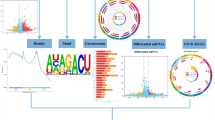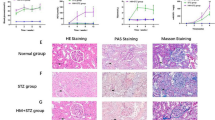Abstract
Moringa isothiocyanate (MIC-1) is a bioactive constituent found abundantly in Moringa oleifera which possesses antioxidant and anti-inflammation properties. However, epigenome and transcriptome effects of MIC-1 in kidney mesangial cells challenged with high glucose (HG), a pre-condition for diabetic nephropathy (DN) remain unknown. Herein, we examined the transcriptome gene expression and epigenome DNA methylation in mouse kidney mesangial cells (MES13) using next-generation sequencing (NGS) technology. After HG treatment, epigenome and transcriptome were significantly altered. More importantly, MIC-1 exposure reversed some of the changes caused by HG. Integrative analysis of RNA-Seq data identified 20 canonical pathways showing inverse correlations between HG and MIC-1. These pathways included GNRH signaling, P2Y purigenic receptor signaling pathway, calcium signaling, LPS/IL-1-mediated inhibition of RXR function, and oxidative ethanol degradation III. In terms of alteration of DNA methylation patterns, 173 differentially methylation regions (DMRs) between the HG group and low glucose (LG) group and 149 DMRs between the MIC-1 group and the HG group were found. Several HG related DMRs could be reversed by MIC-1 treatment. Integrative analysis of RNA-Seq and Methyl-Seq data yielded a subset of genes associated with HG and MIC-1, and the gene expression changes may be driven by promoter CpG status. These genes include Col4a2, Tceal3, Ret, and Agt. In summary, our study provides novel insights related to transcriptomic and epigenomic/CpG methylomic alterations in MES13 upon challenged by HG but importantly, MIC-1 treatment reverses some of the transcriptome and epigenome/CpG methylome. These results may provide potential molecular targets and therapeutic strategies for DN.







Similar content being viewed by others
Abbreviations
- DEGs:
-
Differential expressed genes
- DMRs:
-
Differentially methylation regions
- DN:
-
Diabetic nephropathy
- DSS:
-
Dextran sulfate sodium
- ESRD:
-
End-stage renal disease
- HG:
-
High glucose
- IPA:
-
Ingenuity Pathway Analysis
- ROS:
-
Reactive oxygen species
- TSS:
-
Transcription start site
- LG:
-
Low glucose
- MIC-1:
-
Moringa isothiocyanate
- MES13:
-
Mesangial cells
- NGS:
-
Next-generation sequencing
- Nrf2:
-
Nuclear factor (erythroid-derived 2)-like 2
References
Thomas MC, Cooper ME, Zimmet P. Changing epidemiology of type 2 diabetes mellitus and associated chronic kidney disease. Nat Rev Nephrol. 2016;12(2):73–81.
Tuttle KR, Bakris GL, Bilous RW, Chiang JL, De Boer IH, Goldstein-Fuchs J, et al. Diabetic kidney disease: a report from an ADA Consensus Conference. Am J Kidney Dis. 2014;64(4):510–33.
de Boer IH, Rue TC, Hall YN, Heagerty PJ, Weiss NS, Himmelfarb J. Temporal trends in the prevalence of diabetic kidney disease in the United States. Jama. 2011;305(24):2532–9.
Shahbazian H, Rezaii I. Diabetic kidney disease; review of the current knowledge. J Renal Injury Prevent. 2013;2(2):73–80.
Yaribeygi H, Atkin SL. Interleukin-18 and diabetic nephropathy: a review. 2019;234(5):5674–82.
Lim AK, Tesch GH. Inflammation in diabetic nephropathy. Mediators of Inflammation 2012;2012:146154.
Medzhitov R. Origin and physiological roles of inflammation. Nature. 2008;454(7203):428–35.
Kashihara N, Haruna Y, Kondeti KV, Kanwar SY. Oxidative stress in diabetic nephropathy. Curr Med Chem. 2010;17(34):4256–69.
Kato M, Natarajan R. Diabetic nephropathy—emerging epigenetic mechanisms. Nat Rev Nephrol. 2014;10(9):517–30.
Lu Z, Liu N, Wang F. Epigenetic regulations in diabetic nephropathy. J Diabetes Res. 2017;2017:7805058.
Huang D, Cui L, Ahmed S, Zainab F, Wu Q, Wang X, et al. An overview of epigenetic agents and natural nutrition products targeting DNA methyltransferase, histone deacetylases and microRNAs. Food Chem Toxicol. 2019;123:574–94.
Guo Y, Su Z-Y, Kong A-NT. Current perspectives on epigenetic modifications by dietary chemopreventive and herbal phytochemicals. Curr Pharmacol Rep. 2015;1(4):245–57.
Yuqing Yang A, Kim H, Li W, Tony Kong A-N. Natural compound-derived epigenetic regulators targeting epigenetic readers, writers and erasers. Curr Top Med Chem. 2016;16(7):697–713.
Bennett RN, Mellon FA, Foidl N, Pratt JH, Dupont MS, Perkins L, et al. Profiling glucosinolates and phenolics in vegetative and reproductive tissues of the multi-purpose trees Moringa oleifera L. (Horseradish tree) and Moringa stenopetala L. J Agric Food Chem. 2003;51(12):3546–53.
Leone A, Spada A, Battezzati A, Schiraldi A, Aristil J, Bertoli S. Cultivation, genetic, ethnopharmacology, phytochemistry and pharmacology of Moringa oleifera leaves: an overview. Int J Mol Sci. 2015;16(6):12791–835.
Yassa HD, Tohamy AF. Extract of Moringa oleifera leaves ameliorates streptozotocin-induced diabetes mellitus in adult rats. Acta Histochem. 2014;116(5):844–54.
Cheng D, Gao L, Su S, Sargsyan D, Wu R, Raskin I, et al. Moringa isothiocyanate activates Nrf2: potential role in diabetic nephropathy. AAPS J. 2019;21(2):31.
Wang C, Wu R, Sargsyan D, Zheng M, Li S, Yin R, et al. CpG methyl-seq and RNA-seq epigenomic and transcriptomic studies on the preventive effects of Moringa isothiocyanate in mouse epidermal JB6 cells induced by the tumor promoter TPA. J Nutr Biochem. 2019;68:69–78.
Kim D, Li HY, Lee JH, Oh YS, Jun H-S. Lysophosphatidic acid increases mesangial cell proliferation in models of diabetic nephropathy via Rac1/MAPK/KLF5 signaling. Exp Mol Med. 2019;51(2):18.
Yano N, Suzuki D, Endoh M, Zhao TC, Padbury JF, Tseng Y-T. A novel phosphoinositide 3-kinase-dependent pathway for angiotensin II/AT-1 receptor-mediated induction of collagen synthesis in MES-13 mesangial cells. J Biol Chem. 2007;282(26):18819–30.
Yano N, Suzuki D, Endoh M, Cao TN, Dahdah JR, Tseng A, et al. High ambient glucose induces angiotensin-independent AT-1 receptor activation, leading to increases in proliferation and extracellular matrix accumulation in MES-13 mesangial cells. Biochem J. 2009;423(1):129–43.
Ho C, Lee PH, Hsu YC, Wang FS, Huang YT, Lin CL. Sustained Wnt/beta-catenin signaling rescues high glucose induction of transforming growth factor-beta1-mediated renal fibrosis. Am J Med Sci. 2012;344(5):374–82.
Catherwood MA, Powell LA, Anderson P, McMaster D, Sharpe PC, Trimble ER. Glucose-induced oxidative stress in mesangial cells. Kidney Int. 2002;61(2):599–608.
Shendure J, Ji H. Next-generation DNA sequencing. Nat Biotechnol. 2008;26(10):1135–45.
Goodwin S, McPherson JD, McCombie WR. Coming of age: ten years of next-generation sequencing technologies. Nat Rev Genet. 2016;17(6):333–51.
Zhang Z, Yuan W, Sun L, Szeto F, Wong K, Li X, et al. 1,25-Dihydroxyvitamin D3 targeting of NF-κB suppresses high glucose-induced MCP-1 expression in mesangial cells. Kidney Int. 2007;72(2):193–201.
Li W, Sargsyan D, Wu R, Li S, Wang L, Cheng D, et al. DNA methylome and transcriptome alterations in high glucose-induced diabetic nephropathy cellular model and identification of novel targets for treatment by tanshinone IIA. Chem Res Toxicol. 2019;32:1977–88.
Yang Y, Wu R, Sargsyan D, Yin R, Kuo H-C, Yang I, et al. UVB drives different stages of epigenome alterations during progression of skin cancer. Cancer Lett. 2019;449:20–30.
Guo Y, Wu R, Gaspar JM, Sargsyan D, Su Z-Y, Zhang C, et al. DNA methylome and transcriptome alterations and cancer prevention by curcumin in colitis-accelerated colon cancer in mice. Carcinogenesis. 2018;39(5):669–80.
Storey JD. The positive false discovery rate: a Bayesian interpretation and the q-value. Ann Stat. 2003;31(6):2013–35.
Gaspar JM, Hart RP. DMRfinder: efficiently identifying differentially methylated regions from MethylC-seq data. BMC Bioinf. 2017;18(1):528.
Elmarakby AA, Sullivan JC. Relationship between oxidative stress and inflammatory cytokines in diabetic nephropathy. Cardiovasc Ther. 2012;30(1):49–59.
Ruiz S, Pergola PE, Zager RA, Vaziri ND. Targeting the transcription factor Nrf2 to ameliorate oxidative stress and inflammation in chronic kidney disease. Kidney Int. 2013;83(6):1029–41.
Ha H, Lee HB. Reactive oxygen species as glucose signaling molecules in mesangial cells cultured under high glucose. Kidney Int. 2000;58:S19–25.
Inoguchi T, Li P, Umeda F, Yu HY, Kakimoto M, Imamura M, et al. High glucose level and free fatty acid stimulate reactive oxygen species production through protein kinase C--dependent activation of NAD (P) H oxidase in cultured vascular cells. Diabetes. 2000;49(11):1939–45.
Kim Y, Wu AG, Jaja-Chimedza A, Graf BL, Waterman C, Verzi MP, et al. Isothiocyanate-enriched moringa seed extract alleviates ulcerative colitis symptoms in mice. PLoS One. 2017;12(9):e0184709.
Uruno A, Motohashi H. The Keap1–Nrf2 system as an in vivo sensor for electrophiles. Nitric Oxide. 2011;25(2):153–60.
Ahmed SMU, Luo L, Namani A, Wang XJ, Tang X. Nrf2 signaling pathway: pivotal roles in inflammation. Biochim Biophys Acta (BBA)-Mol Basisf Dis. 2017;1863(2):585–97.
Itoh K, Mochizuki M, Ishii Y, Ishii T, Shibata T, Kawamoto Y, et al. Transcription factor Nrf2 regulates inflammation by mediating the effect of 15-deoxy-Δ12, 14-prostaglandin J2. Mol Cell Biol. 2004;24(1):36–45.
Esteller M. Epigenetics in cancer. N Engl J Med. 2008;358(11):1148–59.
Oba S, Ayuzawa N, Nishimoto M, Kawarazaki W, Ueda K, Hirohama D, et al. Aberrant DNA methylation of Tgfb1 in diabetic kidney mesangial cells. Sci Rep. 2018;8(1):16338.
Jones PA. Functions of DNA methylation: islands, start sites, gene bodies and beyond. Nat Rev Genet. 2012;13(7):484–92.
Yang X, Han H, De Carvalho DD, Lay FD, Jones PA, Liang G. Gene body methylation can alter gene expression and is a therapeutic target in cancer. Cancer Cell. 2014;26(4):577–90.
Funding
This study was supported by R01AT009152 from the National Center for Complementary & Alternative Medicine (NCCAM) and R01CA200129 from the National Cancer Institute (NCI). The authors appreciate all the members of Dr. Kong’s laboratory for their invaluable support and technical assistance.
Author information
Authors and Affiliations
Corresponding author
Ethics declarations
Conflict of Interest
The authors declare that they have no conflict of interest.
Additional information
Guest Editors: Ah-Ng Tony Kong and Chi Chen
Publisher’s Note
Springer Nature remains neutral with regard to jurisdictional claims in published maps and institutional affiliations.
Rights and permissions
About this article
Cite this article
Li, S., Li, W., Wu, R. et al. Epigenome and transcriptome study of moringa isothiocyanate in mouse kidney mesangial cells induced by high glucose, a potential model for diabetic-induced nephropathy. AAPS J 22, 8 (2020). https://doi.org/10.1208/s12248-019-0393-z
Received:
Accepted:
Published:
DOI: https://doi.org/10.1208/s12248-019-0393-z




